
Hove is a seaside resort in East Sussex, England. Alongside Brighton, it is one of the two main parts of the city of Brighton and Hove.

Hangleton is a suburb of Brighton and Hove, in the ceremonial county of East Sussex, England. The area was developed in the 1930s after it was incorporated into the Borough of Hove, but has ancient origins: its parish church was founded in the 11th century and retains 12th-century fabric; the medieval manor house is Hove's oldest secular building. The village became depopulated in the medieval era and the church fell into ruins, and the population in the isolated hilltop parish only reached 100 in the early 20th century; but rapid 20th-century development resulted in more than 6,000 people living in Hangleton in 1951 and over 9,000 in 1961. By 2013, the population exceeded 14,000.

St Leonard's Church is an Anglican church in Hove, in the English city of Brighton and Hove. It is on New Church Road in the Aldrington area of Hove, which was previously a separate village, and it serves as Aldrington's parish church. The church was on Church Road but now stands on New Church Road, renamed in reference to the other church which was started in 1894 as a chapel of ease.

Aldrington is an area in the city of Brighton and Hove in the ceremonial county of East Sussex, England. It was formerly a civil parish. For centuries it was meadow land along the English Channel stretching west from the old village of Hove to the old mouth of the River Adur, and it is now a prosperous residential area integrated within Hove.

St Helen's Church, an Anglican church in the Hangleton area of Hove, is the oldest surviving building in the English city of Brighton and Hove. It is the ancient parish church of Hangleton, an isolated South Downs village that was abandoned by the Middle Ages and was open farmland until the Interwar Period, when extensive residential development took place.

St Peter's Church is an Anglican church in the West Blatchington area of Hove, part of the English city of Brighton and Hove. Although it has 11th- and 12th-century origins, the church was rebuilt from a ruined state in the late 19th century and extended substantially in the 1960s, and little trace remains of the ancient building. The church serves the parish of West Blatchington, a residential area in the north of Hove near the border with Brighton.

St Nicolas Church is an Anglican church in the Portslade area of the English city of Brighton and Hove. It has 12th-century origins, and serves the old village of Portslade, inland from the mostly 19th-century Portslade-by-Sea area.
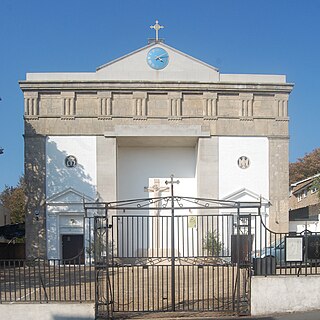
The Church of the Holy Trinity is a Greek Orthodox church in Brighton, part of the English city of Brighton and Hove. Built in 1838 in one of Brighton's most notorious slum districts, Carlton Hill, it was an Anglican church for most of its life: dedicated to St John the Evangelist, it was used by the Anglican community until it was declared redundant in 1980. After some uncertainty about its future, it was sold to Brighton's Greek Orthodox community in 1985 and has been used as their permanent place of worship since then. Reflecting its architectural and historical importance, it has been listed at Grade II since 1971.
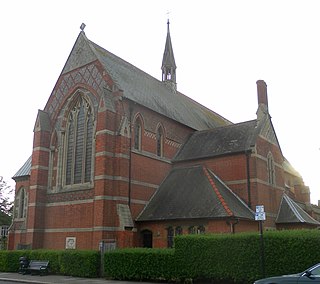
St Philip's Church is a Church of England parish church in Hove, in the city of Brighton and Hove, England. It was opened in 1895 and consecrated in 1898 on New Church Road, near Aldrington's parish church of St Leonard's. It has come under threat of closure but is still active as of 2012. It is a Grade II listed building.

Hove Methodist Church is one of five extant Methodist churches in the city of Brighton and Hove, England. Founded on a site on Portland Road, one of Hove's main roads, in the late 19th century by a long-established Wesleyan community, it was extended in the 1960s and is now a focus for various social activities as well as worship. The red-brick building has been listed at Grade II by English Heritage in view of its architectural importance.

Holland Road Baptist Church is a Baptist church in Hove, part of the English city of Brighton and Hove. Built in 1887 to replace a temporary building on the same site, which had in turn superseded the congregation's previous meeting place in a nearby gymnasium, it expanded to take in nearby buildings and is a landmark on Holland Road, a main north–south route in Hove. It is one of ten extant Baptist church buildings in the city, and is the only one to have been listed by English Heritage in view of its architectural importance.
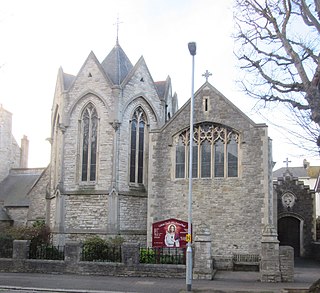
The Church of the Sacred Heart is a Roman Catholic church in Hove, part of the English city of Brighton and Hove. It is the oldest of Hove's three Roman Catholic churches, and one of eleven in the city area. It has been designated a Grade II Listed building.
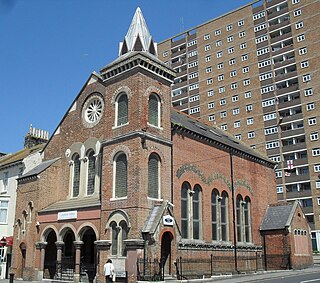
Bristol Road Methodist Church is a former Methodist place of worship in the Kemptown area of Brighton, part of the English city of Brighton and Hove. Built in 1873 to an Italian Romanesque Revival design, it served this part of eastern Brighton for more than a century until its closure in 1989, after which it became a recording studio. It is owned by Brighton College, a private school based nearby. The building has been listed at Grade II in view of its architectural importance.

There are 72 Grade II* listed buildings in the city of Brighton and Hove, England. The city, on the English Channel coast approximately 52 miles (84 km) south of London, was formed as a unitary authority in 1997 by the merger of the neighbouring towns of Brighton and Hove. Queen Elizabeth II granted city status in 2000.

The English coastal city of Brighton and Hove, made up of the formerly separate Boroughs of Brighton and Hove in East Sussex, has a wide range of cemeteries throughout its urban area. Many were established in the mid-19th century, a time in which the Victorian "cult of death" encouraged extravagant, expensive memorials set in carefully cultivated landscapes which were even recommended as tourist attractions. Some of the largest, such as the Extra Mural Cemetery and the Brighton and Preston Cemetery, were set in particularly impressive natural landscapes. Brighton and Hove City Council, the local authority responsible for public services in the city, manages seven cemeteries, one of which also has the city's main crematorium. An eighth cemetery and a second crematorium are owned by a private company. Many cemeteries are full and no longer accept new burials. The council maintains administrative offices and a mortuary at the Woodvale Cemetery, and employs a coroner and support staff.
Cox & Barnard Ltd was a stained glass designer and manufacturer based in Hove, part of the English city of Brighton and Hove. The company was founded in Hove in 1919 and specialised in stained glass for churches and decorative glass products. Many commissions came from Anglican and Roman Catholic churches in the English counties of East Sussex, West Sussex and Kent. The company was also responsible for six war memorial windows at an Anglican church in Canada, made from shards of glass collected from war-damaged church windows across Europe.
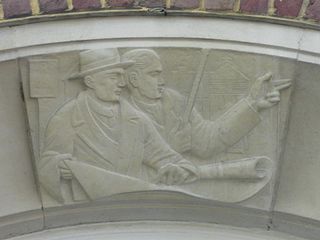
John Leopold DenmanFRIBA was an architect from the English seaside resort of Brighton, now part of the city of Brighton and Hove. He had a prolific career in the area during the 20th century, both on his own and as part of the Denman & Son firm in partnership with his son John Bluet Denman. Described as "the master of ... mid-century Neo-Georgian", Denman was responsible for a range of commercial, civic and religious buildings in Brighton, and pubs and hotels there and elsewhere on the south coast of England on behalf of Brighton's Kemp Town Brewery. He used other architectural styles as well, and was responsible for at least one mansion, several smaller houses, various buildings in cemeteries and crematoria, and alterations to many churches. His work on church restorations has been praised, and he has been called "the leading church architect of his time in Sussex"; he also wrote a book on the ecclesiastical architecture of the county.
Clayton & Black were a firm of architects and surveyors from Brighton, part of the English city of Brighton and Hove. In a career spanning the Victorian, Edwardian and interwar eras, they were responsible for designing and constructing an eclectic range of buildings in the growing town of Brighton and its neighbour Hove. Their work encompassed new residential, commercial, industrial and civic buildings, shopping arcades, churches, schools, cinemas and pubs, and alterations to hotels and other buildings. Later reconstituted as Clayton, Black & Daviel, the company designed some churches in the postwar period.
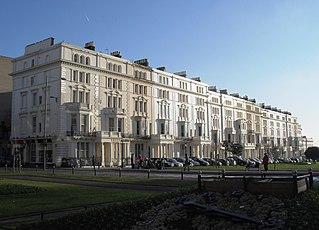
Palmeira Square is a mid-19th-century residential development in Hove, part of the English city and seaside resort of Brighton and Hove. At the southern end it adjoins Adelaide Crescent, another architectural set-piece which leads down to the seafront; large terraced houses occupy its west and east sides, separated by a public garden; and at the north end is one of Hove's main road junctions. This is also called Palmeira Square, and its north side is lined with late 19th-century terraced mansions. Commercial buildings and a church also stand on the main road, which is served by Brighton & Hove bus routes 1, 1A, N1, 2, 5, 5A, 5B, N5, 6, 25, 46, 49, 60, 71, 71A and 96.



























